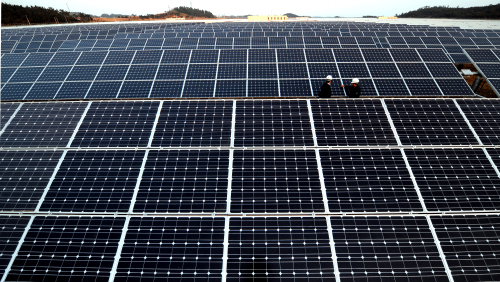The protracted nuclear crisis in Japan and sky-high oil prices are lending fresh impetus to the solar power industry.
Shares of solar energy firms have soared recently amid rising safety concerns about atomic energy. Analysts are increasingly optimistic of the prospect of Korean companies increasing investment in the sector to catch up with global rivals.
Solar power came into prominence with global demand for safer, clean energy sources growing.
Korea has been struggling to cope with hikes in oil costs amid political turmoil in the Middle East and northern Africa.
Further, radiation spreading from crippled reactors in Japan following the earthquake and tsunami is dampening confidence in nuclear power, a viable source of clean energy.
“The trend is leaning toward more stable and sustainable energy sources worldwide,” said JD Song, a research director at Samsung FN.
“Structurally, solar power is the most likely counterpart of nuclear. And its potential is enormous given its tiny 0.7-percent slice in the global power generation market.”
Shares of Seoul-based OCI, the world’s No. 2 maker of polysilicon, a key material of solar cells, went up nearly 55 percent since the beginning of the year and more than 24 percent since Japan’s nuclear crisis.
 |
Workers walk in between rows of photovoltaic modules at a solar power plant in Sinan, South Jeolla Province. (Ahn Hoon/The Korea Herald) |
Solar wafer suppler Osung LST’s stocks nearly doubled between Jan. 11 and March 22, while shares of Woongjin Energy, a solar components maker, had risen almost 32 percent in two weeks as of Wednesday.
“Polysilicon producers are gaining attention because they export all of their output but supply is still tight,” Song said.
A substantial number of small- and medium-scale Korean firms started solar energy businesses around 2008 with government aids, focusing on materials like polysilicon and ingot.
But the overall performances have lagged behind other Asian competitors due to a lack of large investment from major companies and limited funds for smaller developers.
“The scale of investment in facilities from China and Taiwan is gigantic,” Song said. “Except polysilicon, starting Korean companies are about three to four years behind.”
The local industry output grew more than 35-fold to nearly 6 trillion won ($5.4 billion) last year from 166 billion won in 2006.
The global market, valued at around $35 billion last year, is projected to expand about 22 percent this year according to Solar & Energy, a Seoul-based energy research firm.
China is the top cell producer with 35 percent in the market, followed by Japan with 14 percent and Taiwan with 13 percent.
Korea will be able to nearly double its stake to 4.7 percent this year, the researcher said, as a number of conglomerates led by Samsung and LG increased investment to catch up with leaders.
The two electronics titans unveiled each of their 260-megawatt solar modules early this year.
Samsung said in May it would pump 23 trillion won over the next 10 years into solar cell production and other growth engine projects.
LG also plans to scale up investment to 4.7 billion won this year in research and development and raise the energy capacity of panels to 1 gigawatt by 2013.
“The solar industry is one of the fastest growing areas powered by high energy spending and eco-friendly policy measures,” said Cho Kwan-shik, chief of LG Electronics solar business unit.
Hanwha, a Korean leading business group, set up a solar wafer and panel company named Hanwha Solar One, after it bought a 50 percent stake in Shanghai-based Solarfun Power Holdings in August.
SKC, an industrial film manufacturer, announced Thursday a plan to increase its production capacity of polyvinyl fluoride film, a component used to make solar cells, to 4,000 tons by 2012 from the current 1,200 tons.
The SK Group subsidiary said it targets a 30-percent share in the global market in 2012, putting it in second place following DuPont.
Such an aggressive push would help Korea make a leap on the global stage, said Yang Seong-jin, a senior consultant at LG Economic Research Institute.
“Yes they are late, but they can boost competitiveness if they succeed in cutting prices using their vertically integrated operations and funding abilities,” she said.
“The solar business doesn’t require state-of-the-art technologies to enter the market, so low cost is the key to beat rivals.”
By Shin Hyon-hee (
heeshin@heraldcorp.com)







![[Today’s K-pop] Blackpink’s Jennie, Lisa invited to Coachella as solo acts](http://res.heraldm.com/phpwas/restmb_idxmake.php?idx=644&simg=/content/image/2024/11/21/20241121050099_0.jpg)
